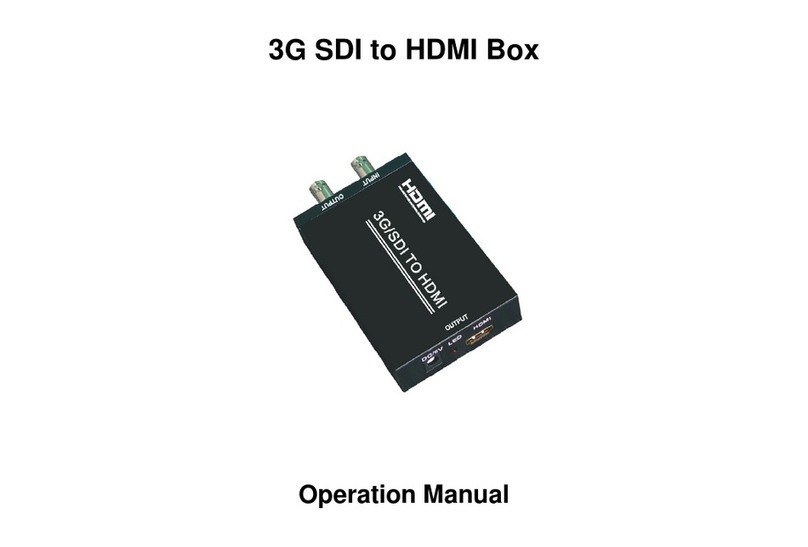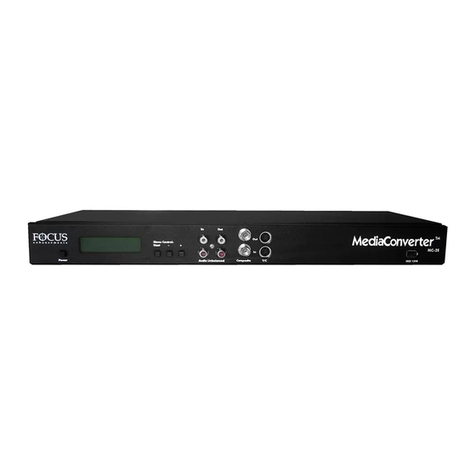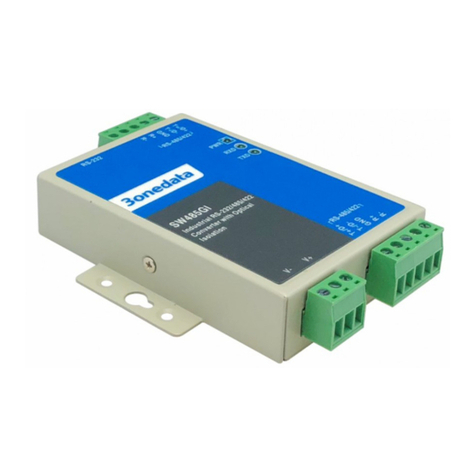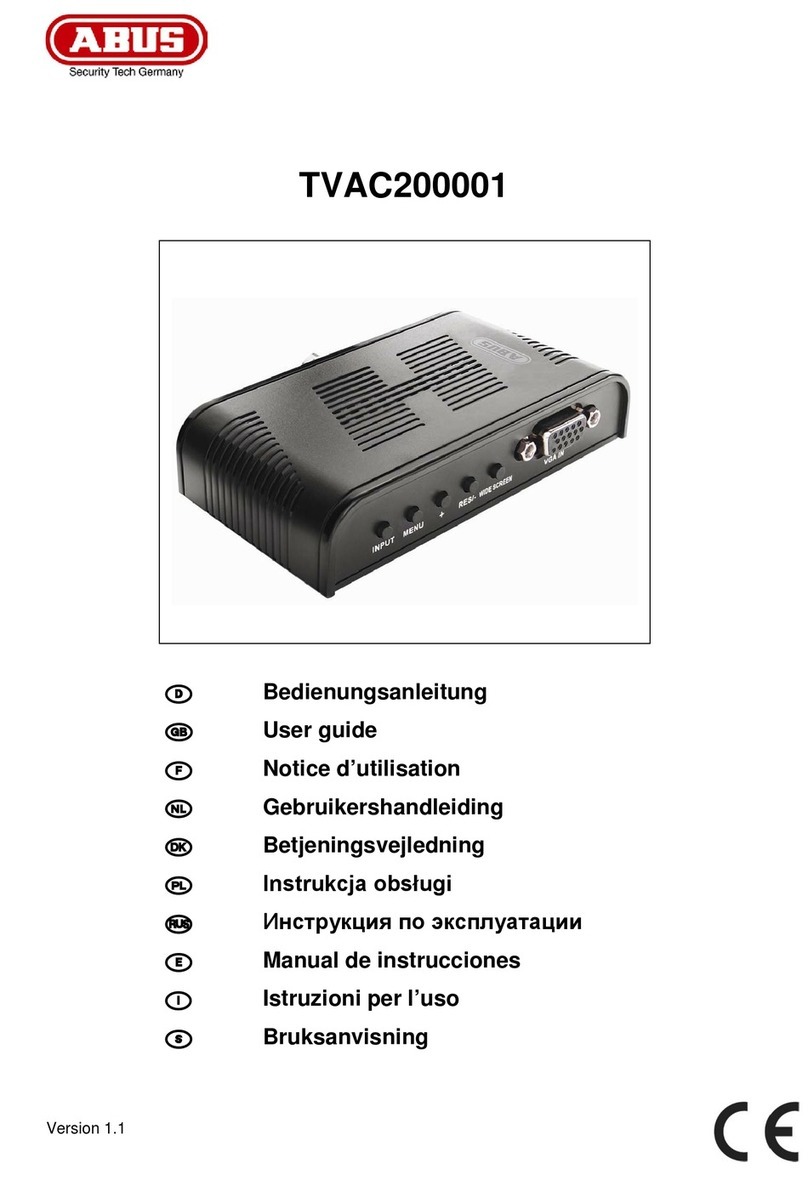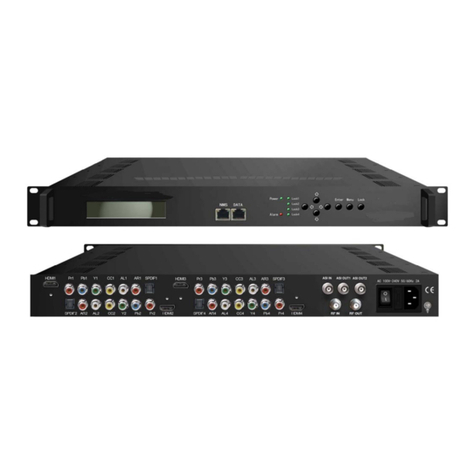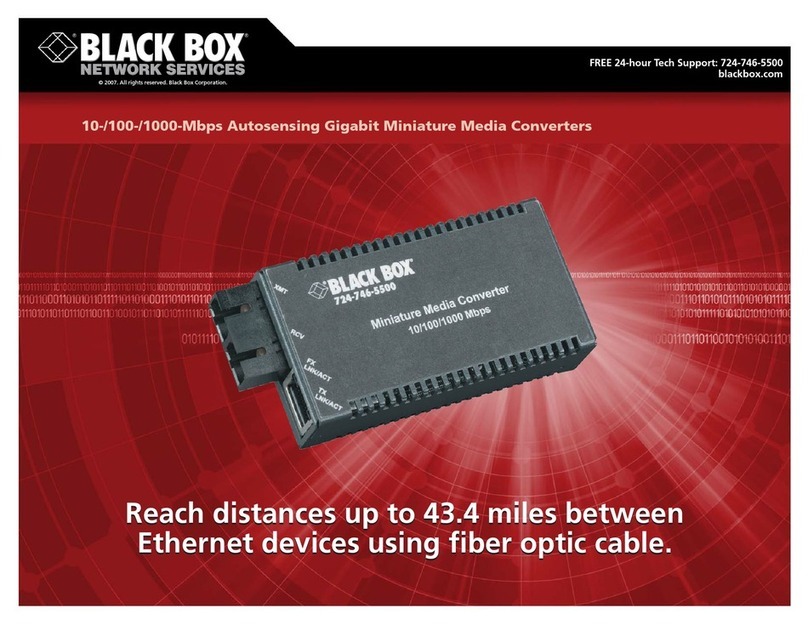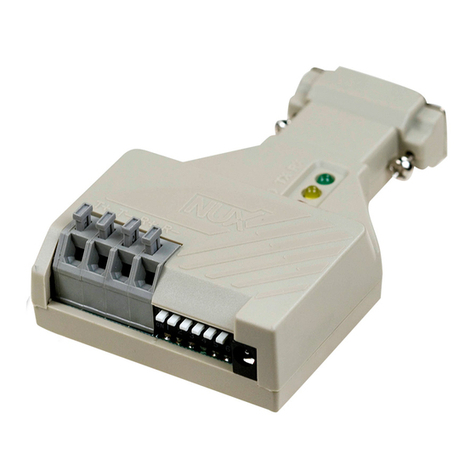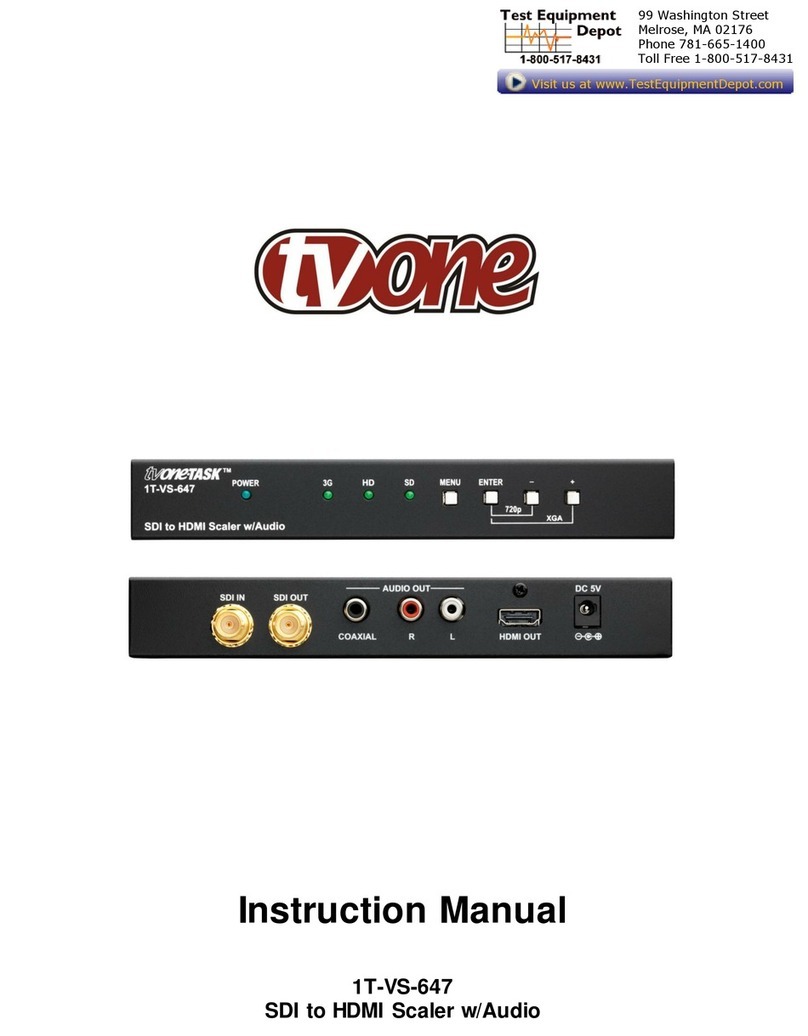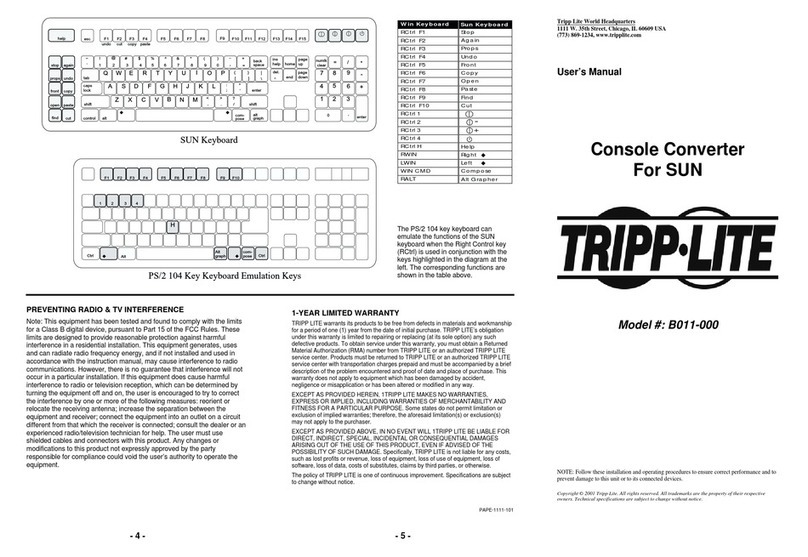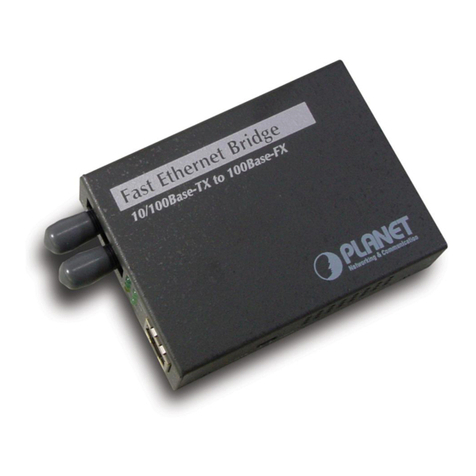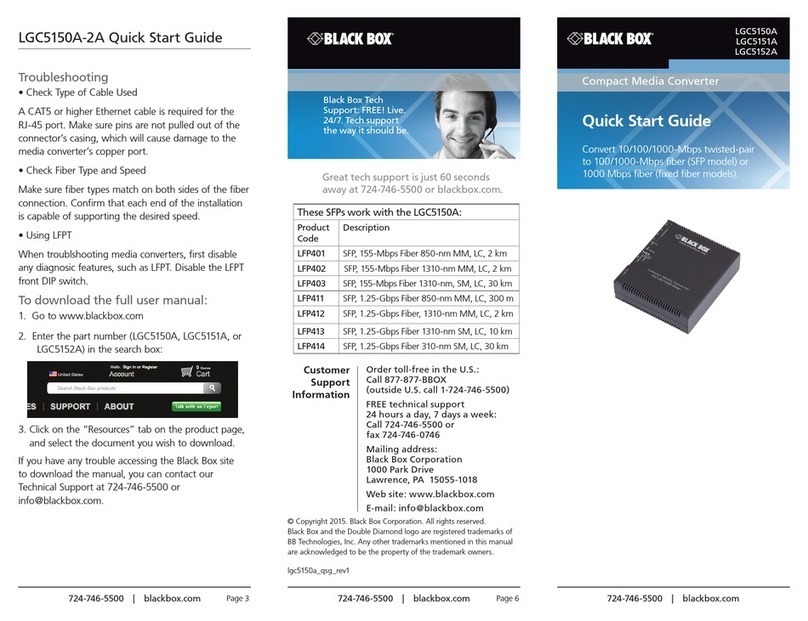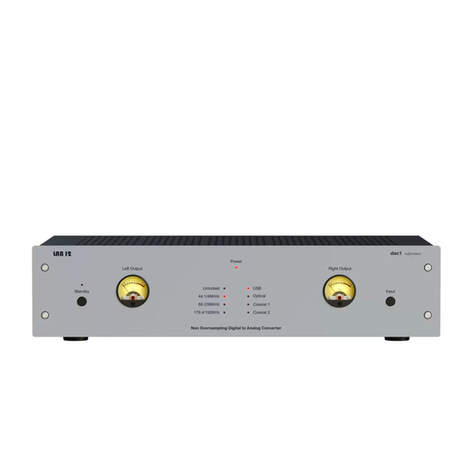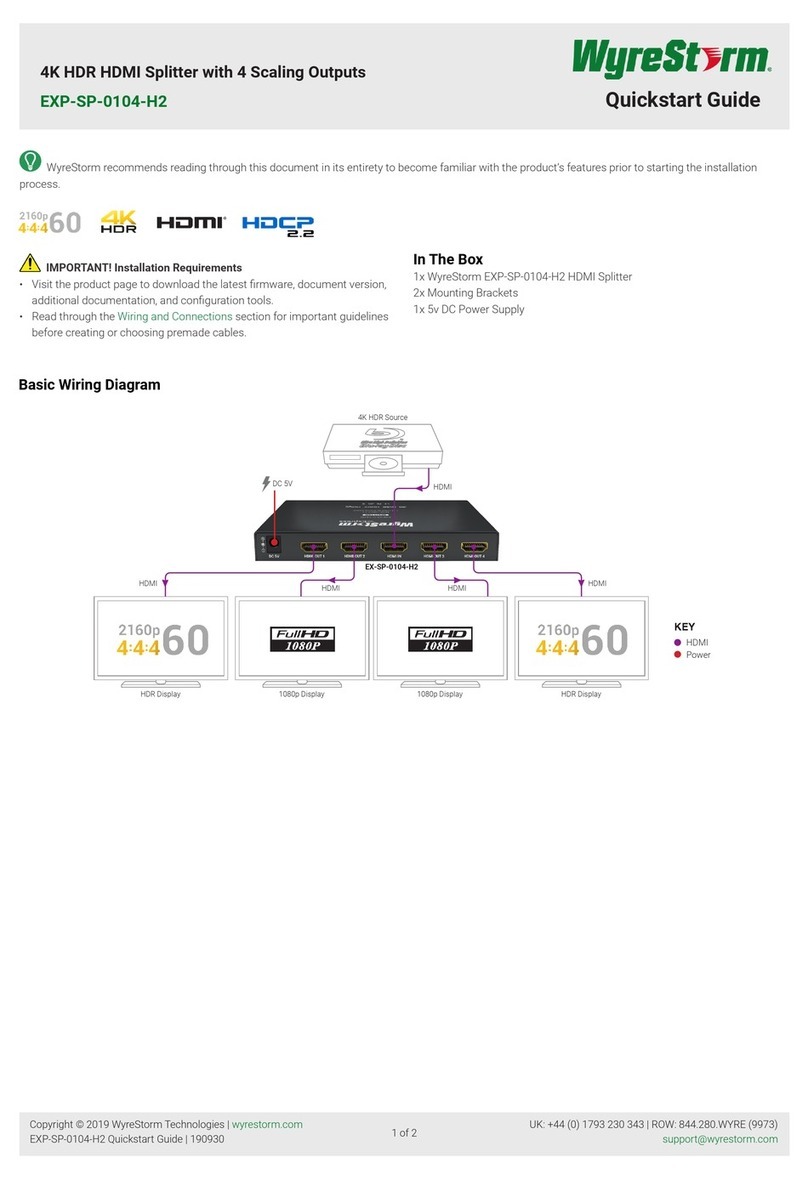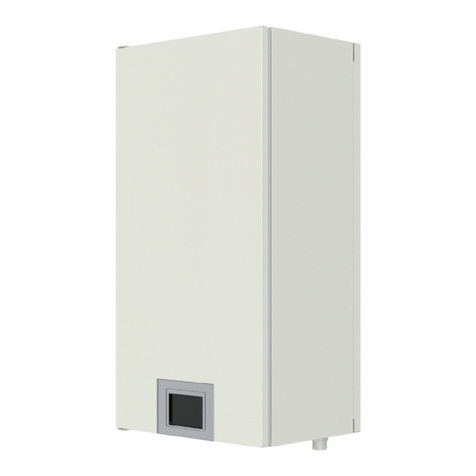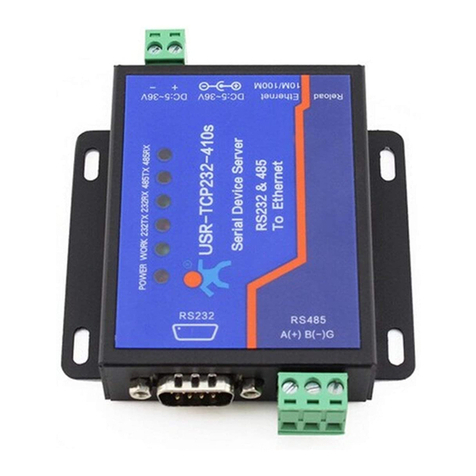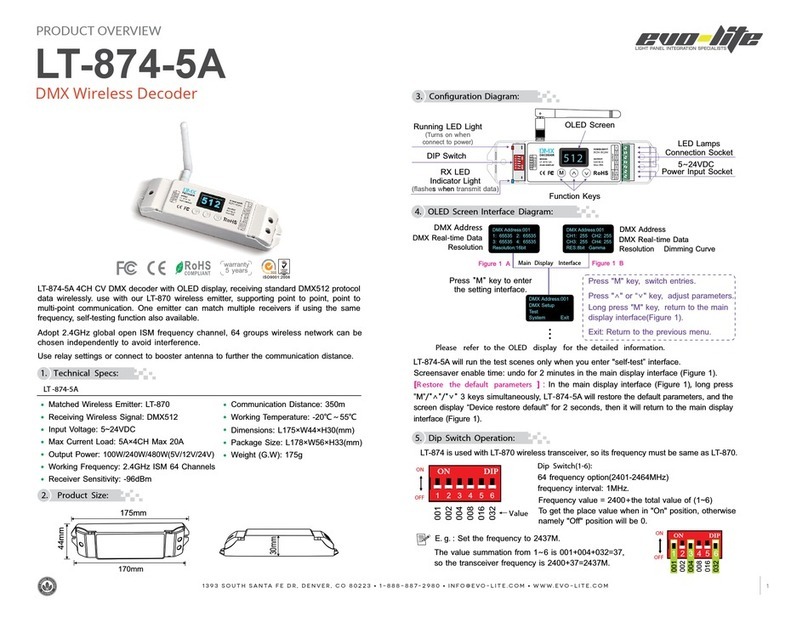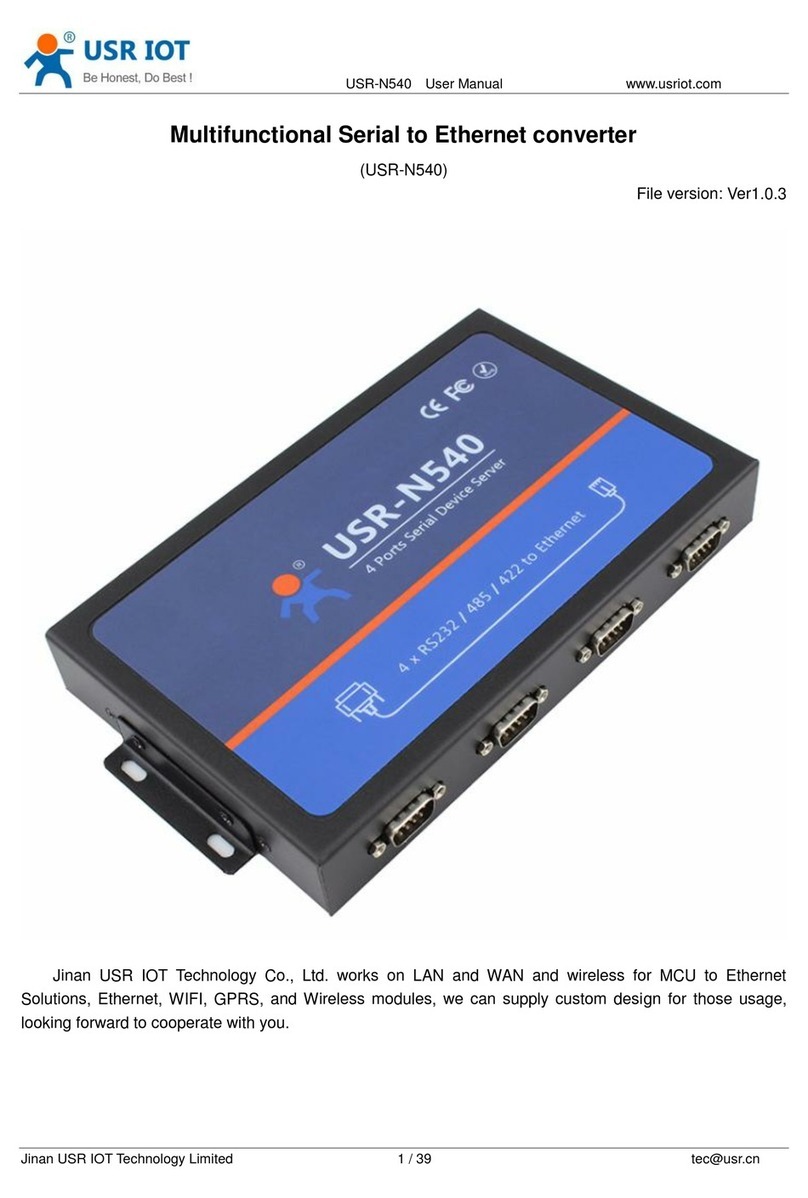Thor Digital HDME-4Q Instruction Manual

1 HDME-4Q Manual V1.0
User Guide and Installation Manual
HDME-4Q
Quad Input HD/SD Encoder

2 HDME-4Q Manual V1.0
Table of Contents
Safety Precautions..........................................................................................................................................3
Package Contents...........................................................................................................................................3
Product Description........................................................................................................................................4
Specifications.................................................................................................................................................5
Installation......................................................................................................................................................6
Hardware Installations and Connections........................................................................................................6
Connecting to the GUI Interface:...................................................................................................................7
Encoder Programming and Setup via GUI Interface:....................................................................................7
Overview Page of Thor Digital Encoder........................................................................................................8
GUI Login Password:.....................................................................................................................................8
Common Setup...............................................................................................................................................9
RF Setup ......................................................................................................................................................11
Encoder Setup..............................................................................................................................................12
Network Configuration................................................................................................................................13
Administration .............................................................................................................................................14
Saving your configuration files....................................................................................................................15
Front Panel LCD Encoder Menu Map.........................................................................................................16
Modulator Configuration via Front Panel LCD...........................................................................................17
Product Notes:..............................................................................................................................................22

3 HDME-4Q Manual V1.0
Safety Precautions
The presence of this symbol is to alert the installer and user to the presence of uninsulated dangerous
voltages within the product’s enclosure that may be of sufficient magnitude to produce a risk of electric
shock.
TO REDUCE THE RISK OF FIRE OR ELECTRIC SHOCK, DO NOT EXPOSE THIS DEVICE
TO RAIN OR MOISTURE. DO NOT OPEN THE UNIT. REFER SERVICING TO QUALIFIED
PERSONNEL ONLY.
DO NOT apply power to the unit until all connections have been made, all components have been installed and
all wiring has been properly terminated.
DO NOT terminate, change or uninstall any wiring without first disconnecting the unit’s power adapter from the
device.
This device is supplied with the appropriately rated power supply. The use of any other power supply could cause
damage and invalidate the manufacturer’s warranty.
DO NOT connect the power cord to the device if the power cord is damaged.
DO NOT cut the power cord.
DO NOT plug the power cord into an AC outlet until all cables and connections to the device have been properly
connected.
The device should be installed in an environment consistent with its operating temperature specifications.
Placement next to heating devices and ducts is to be avoided as doing so may cause damage. The device should not
be placed in areas of high humidity.
DO NOT cover any of the device’s ventilation openings.
DO NOT cover or obstruct the device’s fan or fan openings.
If the device has been in a cold environment allow it to warm to room temperature for at least 2 hours before
connecting to an AC outlet.
Package Contents
This package contains:
One HDME-4Q
One power cable
One installation / configuration manual
Inspect the package before starting installation to ensure there is no damage and all supplied contents are
present.

4 HDME-4Q Manual V1.0
Product Description
Thor Digital's HDME-4Q Encoder/Modulator provides a High Density 4 input MPEG-2/MPEG-4
selectable 2 channel per QAM output making it ideal for any Commercial RF Network. The high quality
HD/SD design allows for watching action packed movies and sports channels on any HDTV. Thor
Digital's 4Q Encoder/Modulator supports a variety of DTV standards. The space saving design delivers 4
High Quality HD/SD channels in a single 1RU space..
High Resolution 1080i/1080p
MPEG2 or MPEG4 (AVC) Selectable Video Output
GUI Interface for Setup and Control
Front panel LCD Display for easy installation
Virtual Channel Mapping
Composite, Component, and HDMI (unencrypted) inputs
MER > 40dB
Closed Captioning Support (708)
+45dBmV Output
Rack mountable 1RU height

5 HDME-4Q Manual V1.0
Specifications
*Subject to change without notifications
INPUTS (VIDEO By Priority)
HDMI 1.4v
Component YPrPb (RCA)
Composite CVBS (RCA)
AUDIO Inputs
Audio Input L/R (RCA)
VIDEO Encoder
Mode MPEG-2, MPEG-4(AVC) Selectable
Video Resoluti ons 1080p(MPEG-4 Only), 1080i, 720p, 576p, 576i, 480p, 480i
AUDIO Encoder
Audio Compression MPEG-1 Layer II, AAC, AC-3 Pass Through
RF QAM SUPPORT
Frequency 54-864 MHz (CH 2 - CH 135)
RF Channel Output 4/2 (4 Inputs / 2 Outputs)
QAM J.83 Annex B
Constellati on QAM256
Bandwidth 6 MHz
RF Level Output +45dBmV Typical
MER >40dB Typical
Interleaver Supported on DVB-C Annex B
Channel Type STD, HRC, IRC
VCN Virtual Channel Mapping (1-16383)
RF Output
Closed Capti oning Control Per Output Control (Use of CVBS Input)
Management / Control
Front Panel LCD Controller Full Support (Up/Down/OK Control Butt ons)
GUI Supported IE9, FireFox, Chrome, Safari
Password Protected Front Panel, GUI
General
Rack mountable (1RU) 19" x 9.45" x 1.75", 19” EIA Standard
Fan Cooled Internal
LCD Front Panel Dual Line, Scrolling Display
“F”- Female 75Ω

6 HDME-4Q Manual V1.0
Installation
System Installer must adhere to Article 820-40 of the NEC that provides guidelines for proper
grounding and specifies that the cable ground shall be connected to the grounding system of the
building, as close to the point of cable entry as possible.
Unpacking and Inspection
Each unit is shipped factory tested. Ensure all items are removed from the container prior to discarding
any packing material.
Thoroughly inspect the unit for shipping damage with particular attention to connectors and controls. If
there is any sign of damage to the unit or damaged or loose connectors contact your distributor
immediately. Do not put the equipment into service if there is any indication of defect or damage.
Hardware Installations and Connections
It is highly recommended that quality cables and connectors be used for all video and audio source
connections.
1. The unit is designed to be rack mounted in a standard EIA 19” rack.
2. The unit comes standard with HDMI, Component, and Composite video inputs. The HDME
encoder / modulator are intelligently designed to detect the video input from the video source.
HDMI Connection: Connect the HDMI cable(s) from the video source(s) into the HDMI
input(s). If using a Component Video Cable, connect the Y (Green), Pb (Blue), and Pr (Red)
video source cable to the unit’s Component input ports. If using a Composite Video source, use a
75Ω coaxial cable with RCA connectors to connect the video source (e.g., CATV, DVD, VCR,
Camera) to the unit’s CVBS port (IN1, IN2, IN3, IN4).
Repeat this step for each video source connection.
3. Component / Composite Audio inputs: Connect A/V audio input (Left / Right Audio) use RCA
cables to connect the audio source to the red / white AUDIO L and AUDIO R INPUT jacks
(IN1…IN2, IN3, IN4). Repeat this step for each audio source connection.
4. Use a quality 75Ω coaxial cable with “F” connectors from the unit’s RF OUT jack to the
distribution system (combiner or reverse splitter) or directly to a television.
5. Connect the included power cord to the unit’s POWER plug.
6. Connect the power cord to an appropriately rated AC power outlet.

7 HDME-4Q Manual V1.0
DEVICE Programming and Setup
To setup and program the Encoder you can use the GUI interface or the LCD Front Panel
Connecting to the GUI Interface:
1. Connect an Ethernet cable directly (no Cross Over cable required) to the Web Management Port
on the rear panel of the encoder or connect the Ethernet cable to an Ethernet switch. Connect an
Ethernet Cable to your PC.
2. Using a Windows-based PC Select Windows Icon
3. Go to My Computer
4. Select Network
5. Allow UPnP to locate and list the device(s) in the right panel
6. Right Click and Select “View device Webpage”.
Note: To setup the encoder using the Front Panel LCD see “Modulator Configuration via
Front Panel LCD”.
Encoder Programming and Setup via GUI Interface:
After connecting the device to the “Web Management” port located on the rear of the device and locating
the device via the 'Network' tool in 'My Computer'
Step 1: Right Click and Select “View device Webpage”

8 HDME-4Q Manual V1.0
Overview Page of Thor Digital Encoder
Welcome page showing overview status of the Encoder when fully functioning.
Alternate between viewing status of RF Output 1 and RF Output 2 by selecting the RF Output section
of the device you want to monitor.
Step 2: Login
Select Common Setup
Once the Common Setup Tab is selected you will be prompted to enter the user name and
password for device.
GUI Login Password:
Default User Name: admin
Default Password: Admin123
Note: To change the Password for the GUI go to the Administration Tab

9 HDME-4Q Manual V1.0
Step 3: Common Setup Tab
Common Setup
Use the Common Setup Page to set the Output channel, Enable VCN Mode, and Device Address.
Step 4: Local Save
Perform a Local Save once all parameters are set.
Notes on Changes:
Changes made to an individual setup tab may require the installer to perform a Local Save AND Upload
and Reboot to the device if you are only making changes to one parameter of the encoder.
Example: Installer is required to change only the output channel for the device (No other changes to the
device are required). Once the channel has been changed, the installer is required to perform 1) Local
Save AND 2) Upload and Reboot.
Notes on Channel Selection: The image below shows the Output Channel is set to CH # 102.

10 HDME-4Q Manual V1.0
RF1 will output 1 QAM signal carrying up to 2 digital audio/video channels (within your device's
Bandwidth settings). The device will automatically set RF2 to Ch # 103.
Physical Channel Outputs examples:
RF1: 102.1, 102.2
RF2: 103.1, 103.2
(See VCN settings to set Virtual Channel Numbers)
The below diagram depicts how each input of Encoder is placed in RF1 or RF2.
Note: The RF2 Physical Channel Output is determined by the selection of output channel of RF1.
RF1 (QAM 1) RF2 (QAM2)
CH # 102 CH # 103
Note: The Encoder prevents you from selecting the last channel in the device as the first physical channel
for the device's output channel. Select CH # 134(855.000MHz) for the output channel and the device will
automatically set RF2 as CH # 135 (861.000MHz).
Setting the Output Channel to CH# 134 would result in the following RF1/RF2 configuration (see below)
RF1 (QAM 1) RF2 (QAM2)
CH # 134 CH #135
Step 5:RF Setup
IN-1
IN-2
IN-3
IN-4
IN-1
IN-2
IN-3
IN-4

11 HDME-4Q Manual V1.0
RF Setup
Use the RF Setup Page to setup each RF Output.
Select RF Output 1 or RF Output 2
Select and set the required parameters you require for your installation.
Step 6: Local Save
Perform a Local Save for each RF Output tab.
Step 7: Encoder Setup

12 HDME-4Q Manual V1.0
Encoder Setup
Select the Encoder 1, 2, 3, 4 tab to program an individual encoder. Select and change all desired
parameters.
Step 8: Local Save for each Encoder tab
Perform a Local Save on EACH Encoder Tab where changes were performed.
***** Ensure all Encoder tab changes have been locally saved
*** Ensure all Encoder changes have been locally saved before performing Step 9 ***
Step 9: Upload and Reboot
Once all the encoder's settings are changed and a Local Save performed for each Setup tab
Select “Upload and Reboot” on the Encoder page. This function will upload and save all parameters set
in the Common, RF, and Encoder sections.
Reminder: If changing only a setting on a specific setup page- remember to perform a Local Save and
Upload and Reboot.
We highly recommend you save your encoder configuration files. See Administration tab for how to
backup your settings.

13 HDME-4Q Manual V1.0
Step 10: Network Configuration Tab
Network Configuration
Use the Network Setup Tab to configure the device’s IP address, Subnet Mask, Gateway, Enable/Disable
DHCP, and set Host Name.
Step 11: Save Network Configuration
Save Config: Once all parameters are set you are required to select Save Config. This function
will reboot and save the changes setting for the Network Configuration.
Note: Only the Network Configuration changes will be saved.

14 HDME-4Q Manual V1.0
Step 12: Administration
Administration
Administration Page Functions
Actions
Reboot
Reboot device. All unsaved settings will be lost.
Reset to Default
Reset all settings back to original factory settings
Backup
Download all settings of device
Upload
Upload a saved config file
New Password
Create and save new password for GUI
****Caution****
Selecting “Reset to Default” will automatically reset all saved settings back to factory default
settings.All saved settings will be lost. ****Caution****
Step 13: If required- change GUI Password and Submit.
Note: When setting a new password you must use the Submit button.
This password is for access to the GUI only. The LCD front Panel Password will not be changed and is set
to prevent unauthorized users access to your device.

15 HDME-4Q Manual V1.0
We highly recommend you save your encoder configuration files. Simply Click the “Backup” button
and the config files will be saved to your computer.
Saving your configuration files
To upload a configuration file- simply click “Choose File” then locate the file you want to upload. Click
“Upload” to install the configuration files. This function is helpful to the installer when installing a large
number of encoders in a single system.

16 HDME-4Q Manual V1.0
Setup Using Front Panel LCD
Front Panel LCD Encoder Menu Map
Main Menu
Common
Setup
RF Setup
Encoder
Setup
Exit
Output
Channel
VCN Mode
Channel
Type
Default
Config
Back to Main
Select RF
Constellation
Interleaver
Regional
Name
RF Output
Device
Address TS ID
Back to Main
Video Input
VCN
Program
Num
Short Name
Long Channel
Name
Aspect Ratio
Video Output
Audio Input
Audio
Output
Closed
Caption
Brightness
Contrast
Saturation
Hue
Back to Main
Back to Main
DHCP
Web Mngt
Network
IPAddress
Subnet Mask
Gateway
Source ID

17 HDME-4Q Manual V1.0
Modulator Configuration via Front Panel LCD
Once the encoder is powered up it will go through its initial booting process. Once the unit has completed
its initial “Booting” up process the LCD will display IN-1..., Bit Rate information, MYDTV-1...., and
other information in the LCD Display Window. When visible the unit is ready for programming or
operation.
The LCD will display data as it cycles through the available information.
Screen Views:
1: Inputs, Mbps, Channel Names, Video Output Type,Audio Output type
2: Use the Scroll Up/Down button to display RF-1 / RF-2 data, Physical Output Channel, Constellation,
and Interleaver.
Main Menu– To access the Main Menu first enter the password by pressing the OK button. Use the
Scroll Up/Down buttons to enter the password. Once the password is entered press the OK button again
and the LCD Screen will display “Main Menu Common Setup”.
Password – Use the Scroll Up/Down buttons to enter the password. Password is 0000. Press the
OK button for each number to enter the password. Press OK again after the display shows …... HD
Series.
RF-1 103(669.0000 MHZ) QAM 256 I128, J1
RF-2 104(675.0000 MHZ) QAM 256 I128, J1
IN-1 8.231Mbps MY-DTV1 MPEG2 MP2
IN-2 8.435Mbps MY-DTV2 MPEG2 MP2
PASSWORD=?
0

18 HDME-4Q Manual V1.0
Common Setup Menu
Output Channel – Use the Scroll Up/Down button to change the output channel. Use the
Scroll Up/Down buttons to select the desired Output Channel. Once the desired output
channel is selected press the OK button to set the channel.
The LCD Display will show both the channel number and the frequency number of the
output channel (example: 103 669.0000MHz)
Note: The RF2 Physical Channel output is determined by the selection of output channel of RF1
The Quad Encoder prevents you from selecting the last channel in the device.
**See “Notes on Channel Selection” for more information on this topic.
VCN Mode - To enable Virtual Channel Number / Mapping Scroll to VCN Menu. Press
OK to enter the VCN menu. Select Enable to turn on VCN functionality. If VCN is not
enabled- the output channels will be dependent on the output channel /physical number.
Factory default: Disable.
Channel Type – Use the Scroll Up/Down button to select Channel Type. Press the OK
button to enter the Channel Type menu. Menu options are STD, HRC and IRC. Factory
default: STD. Use the Scroll Up/Down button to select the desired Channel Type and press
the OK button to set.
Regional Name - Note: Do not Change. Skip this function. Default: USA.
Device Address – Use the Scroll Up/Down button to select Device Address. Press the OK
button to enter the Device Address menu. Use the Scroll Up/Down to select the Desired
Address ranging from 1 to 255 then press OK to set. A unique device address is required if
setting up more than 1 encoder per site. This allows the user to distinguish each device.
Default Configuration –To reset the Encoder/Modulator back to the factory default select
the Default Configuration Menu. Press OK to enter the Default Configuration Menu. Using
the Up/Down button select YES to reset all programmed settings back to the factory
default setting. Factory Default: NO.
Caution: Once the “YES” button is pressed the unit will automatically reset to the factory default
settings. All settings or changes to the encoder/modulator will be lost.
Back to Main- Select Back to Main to escape the Common Setup Menu.
RF Setup Menu
Select RF-Press the OK button to enter the Select RF menu. Use the Scroll Up/Down
button to Select the RF section of the Encoder. Select 1 or Select 2.
Note: The QUAD version of the HDME has 2 RF Sections or QAM outputs. The Quad will place 2 RF
channels in the first QAM output and 2 RF Channels in the second QAM output. (6MHz per QAM).
Constellation – Use the Scroll Up/Down button to select Constellation. Press the OK
button to enter the Constellation menu. Factor Default: QAM256.
Interleaver- Use the Scroll Up/Down button to select the appropriate Interleaver selection.
Press the OK button to enter the Interleaver menu. Use the Scroll Up/Down button to
select the desired Interleaver value and press the OK button to set. Factory default: I=128,
J=1.
RF Output – Use the Scroll Up/Down button to select RF Output. Press the OK button to

19 HDME-4Q Manual V1.0
enter the RF Output menu. Options are Normal, Inverted, or C.W. Factory default: Normal.
Use the Scroll Up/Down button to select the desired RF Output and press the OK button to
set.
TS ID – Use the Scroll Up/Down button to select TS ID. Press the OK button to enter the
TS ID menu. Use the Scroll Up/Down button to select the desired Stream ID ranging from
0 to 65535 then press the OK button to set.
Back to Main- Select Back to Main to escape the RF Setup Menu.
Encoder Setup Menu
Select Encoder- Use the OK button to enter the Select Encoder Menu. Using the Scroll
Up/Down buttons select the encoder you wish to program. Use the OK button to set the
Encoder. Select Encoder 1, 2, 3, or 4 based on your model number.
Once Selected the Display will indicate which Encoder you are programming while in the
setup function
VCN-Use the Scroll Up/Down button to select VCN Menu. Press the OK button to enter
the VCN menu. Set the VCN Channel using the Scroll Up/Down buttons. Set VCN
Channel from 1-16383.
If the unit has VCN enabled - program each Encoder by using the Select Encoder Menu in this
section of the Encoder Menu then set each VCN as required.
Set Virtual Channel from
1-16383
NOTE: We recommend setting a unique number for each program
Default: VCN 1: 101, VCN 2: 102, VCN 3: 103, VCN
4: 104
Example: The output channel is set to 103(699.0000MHz). The user can set a VCN (Virtual Channel
Number) by enabling the VCN function. The Integrator can map the Virtual Channel number to
57 The Virtual Channel Number displayed would be 57. The VCN is independent of the output /
physical channel.
Video Input – Use the Scroll Up/Down button to select Video Input. Press the
OK button to enter the Video Input menu. Use the Scroll Up/Down button to
select the Video Input option: Auto, Composite, Component, or HDMI. Factory
default: Auto. Press the OK button to set.
The HDME series of Encoder/Modulators is designed with Intelligent Input Detection
(IID) technology. If you select Auto, the unit will detect the video input.
Program Num - Use the Scroll Up/Down button to set 1 Program Num(Number). Press
the OK button to enter the Program Num menu. Use the Scroll Up/Down to select the
Program Num ranging from 1 to 65535 then press OK to set.
Short Channel Name – Use the Scroll Up/Down button to select Short Channel Name.
Press the OK button to enter the Short Channel Name menu. Use the Scroll Up/Down
ENCODER SETUP 1
SELECT ENCODER

20 HDME-4Q Manual V1.0
menu to select the first character of the desired Short Channel Name then press the OK
button to set. Repeat the process until the Short Channel Name is completed. If the
modulator has more than one video input scroll through the Advanced Menu for additional
Short channel name menus.
The Short Name can be 7 characters long. Factory Default: MY-DVT1/MY-DVT2, MY-
DVT3, MY-DVT4.
Long Channel Name – Use the Scroll Up/Down button to select Long Channel Name.
Press the OK button to enter the Long Channel Name menu. Use the Scroll Up/Down
menu to select the first character of the desired Long Channel Name then press the OK
button to set. Repeat the process until the Long Channel Name is completed. If the
modulator has more than one video input scroll through the Advanced Menu for additional
Long channel name menus. Factory Default: ATSC-Digital-TV1/ATSC-DIGITAL-TV2,
ATSC-Digital-TV3/ATSC-DIGITAL-TV4. The Long Channel Name can be 16 characters
long.
Source ID - Use the Scroll Up/Down button to set Source ID. Press the OK button to enter
the Source ID menu. Use the Scroll Up/Down to set the Source ID. Range: 1 to 65535.
Press OK to set
Aspect Ratio – Use the Scroll Up/Down button to select Aspect Ratio. Press the OK
button to enter the Aspect Ratio menu. Use the Scroll Up/Down button to select the desired
Aspect Ratio option of 4:3 or 16:9 then press the OK button to set. Factory default: 4:3.
Video Output – Encoder / Modulators may be Dual MODE Capable. The user may select
to output video in either MPEG2 or AVC (MPEG4). Use the Scroll Up/Down button to
select Video Output. Press the OK button to enter the Video Output menu. Use the Scroll
Up/Down button to select the Video Output option: MPEG2 or AVC. Factory default:
MPEG2. Press the OK button to set.
Note: The HDME-4Q allows the installer to select a combination of Video Output formats.
This device will allow the user to have outputs broadcasting in either MPEG2 or AVC
(MPEG4) or a combination of both MPEG2 and AVC (MPEG4).
Audio Input – Use the Scroll Up/Down button to select. Press the OK button to enter the
Audio Input menu. Use the Scroll Up/Down button to select the Audio Input option:
Analog. Factory Set:Analog.
Audio Output – Use the Scroll Up/Down button to select Audio Output. Press the OK
button to enter the Audio Output menu. Use the Scroll Up/Down button to select the Audio
Output option: MP2 (MPEG2 Layer I Audio), or AAC. Factory default: MP2. Press the
OK button to set.
Closed Caption-Use the Scroll Up/Down button to select the Closed Caption Menu. Press
the OK button to enter the Closed Caption menu. Enable / Disable Closed Caption control.
Each Encoder will require you to Enable the Closed Caption option if you require Closed
Captioning Support on a particular video output.
NOTE: WHEN USING CLOSED CAPTIONING- USER MUST CONNECT FROM THE
CONTENT SOURCE THE COMPOSITE OUTPUT OR CC OUTPUT SOURCE TO THE
ENCODER'S CVBS INPUT CONNECTOR.
Brightness – Use the Scroll Up/Down button to select Brightness. Press the OK button to
enter the Brightness menu. Use the Scroll Up/Down button to select the desired Brightness
value (0 to 255) and press the OK button to set. Factory default: 128.
Table of contents
Other Thor Digital Media Converter manuals
